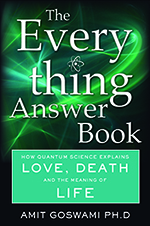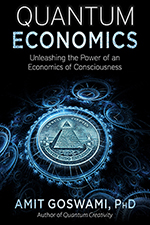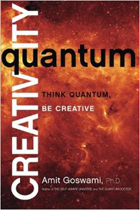Positive Psychology in the Quantum Way Or How to See the Glass Half Full Instead of Half Empty
By Amit Goswami, Ph.D.
We now have a psychology of happiness or what is increasingly called positive psychology. If you question why this is big news, think again. Sixteen years ago, I went to a conference on happiness in Bangalore, India, and a yoga psychologist there introduced the subject thus:
When I was a graduate student in psychology, I asked my professor to define mental health. The professor said, “That is a big subject for me to answer. Check the library.” I went and looked and looked; but all I found were books on abnormal psychology, neurosis and psychosis. Reading these books made me kind of depressed. And the answer to the question, “What is normal mental health?” was not to be found in any of those books. So, I went home and read a book on yoga psychology by Swami Vivekananda and that book lifted my depression in no time. Although I did get my degree in psychiatry for the sake of credentials, I practice only Yoga Psychology.
As this psychologist noted, even sixteen years ago books on traditional academic psychology were heavily biased toward the negative, although a few forces of psychology outside the mainstream did talk about normal mental health and even positive mental health. However, the subject took off when UPENN professor, Martin Seligman, started writing about and teaching what he called positive psychology. Seligman’s psychology was not yoga psychology by any means; Seligman’s worldview remains what we’d categorize as scientific materialism—everything is matter. But still it was a breakthrough of sorts.
However, let it be said that it is tricky to talk about positive psychology within the worldview of scientific materialism, which holds that a human is just comprised of a physical body with a brain and material interactions within the brain and that the body produces all the phenomenon that one “experiences.” Why is this tricky? Because in that worldview, experiences cannot exist. Interactions between material objects can only produce bigger and bigger conglomerates of objects; but experiences have two poles. These are: The subject that experiences and the objects that are experienced. Check this out if you have doubts. Without you, who is checking the validity of this statement? Without you, who is sorting out worldviews? Through sophistry, you might convince yourself (as the majority of scientists still do), that somehow brain interactions make it appear it is like so, but you would not likely succeed in accepting positive psychology without you to be positive and present.
But yoga psychology, which holds a very different view, does not do much better. That psychology’s worldview is called primacy of consciousness. Instead of holding matter is everything, yoga psychology holds the worldview that consciousness is everything. But while the materialist view is reductionist (macro is built of the micro), this worldview is holistic. Hence, consciousness, the whole, is all that exists; consciousness is the one and only. How does separateness and diversity arise then? Well, consciousness has a trick that Indians identify by the Sanskrit word maya. Through this trick, consciousness makes it appear that it divides itself into a subject experiencing objects. Experiences are illusory appearances. Go beyond these experiences and find bhuma, another Sanskrit word meaning wholeness. That will make you happy.
But if you are neutral, you have got to admit that both sides are saying, from two opposite points of view of reductionism or holism, essentially the same thing: experiences are illusory epiphenomena. Of course their recipes for happiness are different: Positive psychology a la Seligman holds that being positive about experiences helps to cope better with life. And positive psychologists site medical reports of this; you can avoid mental illness and even physical illness with positivity, hence, the excitement about positive psychology.
But yoga psychology also makes sense to many people. The word health or the word healing has the same origin as the word whole. In order to really heal, you have to discover the wholeness beyond your separateness. This is what spiritual traditions and their offshoots, the religions, teach. And indeed, there are plenty of people even today who are thus “enlightened,” and they are happy. I myself have met a few; not only are they happy, I found that their happiness is contagious. In their presence, other people become happy.
Some people are excited about the prospect that now that the materialist and the spiritualist (in the above sense) traditions both talk about happiness however different their approaches may be, there is hope for reconciliation between the two views: science and religion. And these people are right. For the past forty years or so some developments of quantum physics are producing a worldview that is integrating the two disparate worldviews—science and religion; there is no doubt about it. But before I present the quantum worldview and how it looks at happiness, let me say a few words about the pragmatic way of looking at happiness.
The Pragmatic View of Happiness
I recently attended a conference on happiness in Puebla, Mexico. The parapsychologist Dr. Stanley Krippner was one of the few scientists involved. After the conference we asked Dr. Krippner what in his view is happiness. And he gave an excellent summary of a practical view of the subject: happiness has four pointers, said he: joy, meaning, satisfaction, and flow. Then he elaborated. I will summarize.
By joy, Krippner means the joy of pleasurable activities, such as the joy of eating, the joy of sex, etc. Mechanical these activities may be, conditioned brain circuits are involved no doubt, but we do feel expanded when we eat or engage in sex, we do become a little magnanimous. And this can be seen as movement toward wholeness, and this movement takes us toward happiness.
A staunch materialist would also point out what Krippner calls joy is really the product of the endorphin molecules being emitted and finding receptor sites and filling them—the strictly mechanical. The joy of pleasure is molecular, implying the experiencer of the pleasure is the material and molecular brain, no need to talk about a consciousness separate from the brain that expands.
About meaning. When we discover new meaning or even understand somebody else’s exploration of meaning such as a piece of art, have you noticed there is happiness in it?
This time, the materialist, if well read will be quiet. Recently there has been a lot of excitement as to why computer scientists have not yet been able to manufacture a meaning-processing computer. In the eighties and nineties, the philosopher John Searle and the mathematician Roger Penrose demonstrated (I’d say “proved”) that meaning is impossible for computing machines to process.
The third in Krippner’s list is satisfaction of a purpose. For example, when we accomplish something purposive, we feel happy as in the case of two businessmen shaking hands on a deal they just concluded that would be mutually profitable. Profit represents abundance, material abundance. When we fulfill our search for archetypes like abundance and the like (love, beauty, justice, truth, goodness etc.), we feel satisfied. This way to happiness is also beyond a materialist explanation.
And finally flow. Krippner gave the example of sportsmen and sportswomen. These people talk about happiness when they are in the zone. Psychologists have given the name flow to such experiences of happiness. You, too have plenty of flow experience while dancing. I once fell into a flow while playing poker. Go figure.
Transpersonal psychology figures it thus. Underneath our ego shines a higher self, the transpersonal self. In flow, we, in our ego, connect to this higher self (also called spirit); we alternate between the ego and this higher self, and the experience is flow. The joy of flow is spiritual joy, and there is no materialist explanation of it.
Then How Should We Look at Occasional Negativity, and Why Psychotherapy?
At the same conference, the psychologist Joan Borysenko was asked the same question, “What is your view of happiness?” Borysenko said she looks at consciousness as “a bright sun in the background implying that our natural state is happiness. But,” said she, “there can be and often are clouds that cover the sun. Because of the clouds of negativity, people fail to access happiness.”
We can easily find many examples of clouds. It is well known that we have negative emotional brain circuits: jealousy, anger, lust, competitiveness, envy, etc. When they cloud our mental sky, we become unhappy. A specific example is found in childhood or adult trauma, for example PTSD—post-traumatic stress disorder. Who hasn’t suffered at least a little of the first and heard of the second, thanks to the rampant incidents of PTSD among war veterans?
So the psychological way to find happiness is to clear up the clouds. Psychotherapists try to do that with various degrees of success, don’t they?
A case in point is substance addiction. People take opium and related substances to fill up the opiate receptor sites that the endorphin molecules fill which the brain itself produces. But to engage the brain that way and forget your pain requires a lot of work. Addiction prone people use opiate molecules taken externally to achieve the same states that endorphins generate, and it is effortless with external drugs. Unfortunately, opiates are addictive. Moreover, once you start using them, your body’s ability to produce endorphins is compromised. This double whammy makes the psychological treatment of addiction very challenging.
A scientific study has shown that only 5-10% of patients find help under the present regimens of healing addiction, and in those cases it is found that the doctors involved were unusually compassionate. Obviously, it is important to give addicts better choices to find happiness than substance addiction. Hence psychotherapy: clean up the unconscious; remove the clouds, and expose the sun to illuminate your life.
Nonetheless, as noted above, with traditional psychotherapy, success in the treatment of addiction has been elusive. Something is missing.
Torn Between Two Worldviews
We are caught between two extremes of two disparate worldviews of scientific materialism on one hand and spirituality on the other hand. In the former, we are told that we are machines and yet encouraged to frame our experiences from a positive mental framework in order to avoid suffering; the hope is that this will enable the brain to change and make positive emotional brain circuits that will balance or overcome the built in negativity of the brain. But this is inconsistent with the materialist worldview because in that worldview the mind is synonymous with the brain, and it is hard to understand what is meant by saying that the brain takes a positive perspective toward its experiences that it could not possibly have as a material machine.
In the latter, we are told that we suffer because of our fundamental ignorance of the fact that suffering itself is an illusion. We are that wholeness, and realizing that, we can eradicate all the roots of suffering.
However, apart from inconsistency, the first approach is of limited value because the ways to achieve a positive mental framework are so limited if we stay within the straightjacket of scientific materialism. The latter approach is even more limited because ways to achieve self-realization that are prescribed are tough for ordinary people to practice and success with those prescriptions has been fairly limited anyway.
So comes the quantum worldview and quantum psychology.
Quantum Psychology
The quantum worldview holds that:
1) Consciousness is the ground of all being, and objects are quantum possibilities from which consciousness chooses its experiences.
2) There are four kinds of possibility worlds within consciousness—physical, vital, mental, and supra-mental/archetypal. When consciousness chooses from physical or material possibilities, we experience a physical object; we call the experience sensing. When the choice is from the vital world, what is manifested is vital energy that we feel. When consciousness chooses from the mental world of meaning, we call the experience thinking. And when consciousness chooses from the supra-mental world of the archetypes such as love, beauty, truth, goodness, justice, or abundance, we call the experience intuiting.
3) In the process of the conversion of possibility into manifest experience, consciousness identifies with the experiencer’s brain and becomes the brain’s “I.” Before conversion, there is only oneness, the realm of quantum potentiality that psychologists, starting with Freud, call the unconscious. After conversion, the one becomes two, subject and object, and eventually many because there are so many brains. This is the world of manifest awareness. The world of manifestation includes the space-time external world of matter and the three internal worlds of the psyche.
4) This self of the brain co-arising with the object of experience—be it physical, mental, vital or archetypal—has no distinguishing character or personality. We call it the quantum self. What we experience more often is the ego character, which is a bunch of habit patterns acquired by consciousness in response to recurring stimuli; as a result, consciousness now identifies with this ego-character. Furthermore, the ability of being conscious in the past gives consciousness the prerogative to develop various personas to be taken on in various situations. It is this ego/character/persona that we most often experience as self, our “I”. What was “I am” in the quantum self experience becomes “I am this” in the ego-character-persona, which causes confusion.
5) The event of conversion of possibility into actuality is purposive. The purpose of evolution is to make the experiences of feeling, meaning, and intuiting better and better. Matter makes representations of the vital feelings (organs at the chakras) and the mental meanings (memory in the neocortex) that living beings experience. In this way, evolution of life is an evolution of the representation-making capacity of the physical body of the living beings.
6) Starting about 5000 years ago, human beings at various places such as India, China, the Middle East, and Greece, discovered the archetypes and learned to make representations of them in the physical body through the intermediary of mental and vital representations of them.
7) Making living representations of the archetypes in the body (in other words embodying them) is a time-consuming task. Fortunately, the quantum worldview supports the idea of reincarnation. We get many chances to embody the archetypes.
8) The process leading to making representations of new meaning, especially new meaning in a new archetypal context is the creative process. The quantum worldview gives us a very tangible and workable explanation of the creative process. As a result, for making positive changes in the way we live, we not only can use reconditioning of the brain but also creativity.
In this way, in quantum psychology based on these dicta, we can live happiness in all the ways that Krippner mentioned and one more: living the pleasure circuits of the brain, the physical way; living with positive feelings centered around the body’s associated chakras, the vital way; living in a meaning centered way with understanding rather than information processing, this is the mental style of happy living; living purposively, with one or more archetypes to guide us, developing supra-mental intelligence; and finally, living in flow while dancing with the spirit, which is another name of the quantum self—the spiritual way of happy living.
Of course, quantum psychology, additionally points us to the way of jumping out of the bondage of the world entirely as in yoga psychology.
Positive feelings, processing of new meaning, and purposive engagements with the archetypes, all are momentary experiences of the quantum self which shines in us like the sun in the background of the sky of the psyche. Clouds in the sky arise from negative emotional brain circuits, negative emotional conditioning including trauma, negative traits of habits—personal and socio-cultural—that block purposiveness and creativity; so therapy—self-help or guided by a therapist—is needed. However, we now can point out what is missing in the psychotherapy for addiction—creativity. In quantum psychotherapy, we always use creativity.



